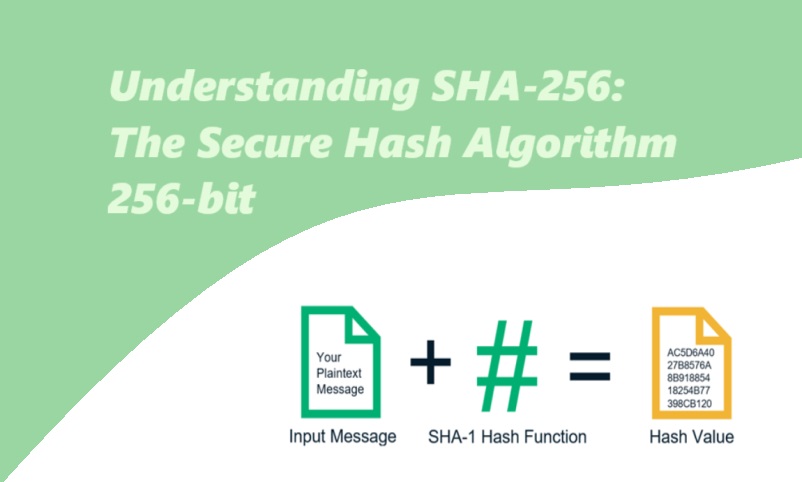In the world of cryptography and security, the SHA-256 algorithm plays a crucial role. This cryptographic hash function generates a 256-bit (32-byte) hash value, providing a high level of security for various applications and protocols. Let’s dive deeper into the workings and applications of SHA-256.
What is SHA-256?
SHA-256, which stands for Secure Hash Algorithm 256-bit, is a member of the SHA-2 (Secure Hash Algorithm 2) family of cryptographic hash functions. It was developed by the National Security Agency (NSA) in the United States and published by the National Institute of Standards and Technology (NIST) in 2001.
As a hash function, SHA-256 takes an input (message) of any length and produces a fixed-size output (hash value) of 256 bits. The resulting hash value is unique to the input, meaning even a small change in the input will result in a significantly different hash value.
How does SHA-256 work?
SHA-256 operates on a series of logical operations, including bitwise operations, modular addition, and logical functions like AND, OR, and XOR. It processes the input message in blocks of 512 bits and produces a hash value by iteratively applying these operations.
The algorithm employs a Merkle-Damgård construction, which means that it breaks the input message into fixed-size blocks and processes them one at a time. Each block is processed using a compression function that combines the current block with the previous hash value. This process continues until all blocks are processed, resulting in the final hash value.
Applications of SHA-256
SHA-256 has found widespread use in various security applications and protocols due to its strong cryptographic properties. Here are some notable applications:
Bitcoin Mining
SHA-256 is an integral part of the Bitcoin protocol. In the context of Bitcoin mining, miners compete to solve a complex mathematical puzzle by finding a hash value that meets certain criteria. The SHA-256 algorithm is used to hash the block data, and miners must find a hash value that is below a specific target value. This process requires significant computational power and ensures the security and integrity of the Bitcoin network.
Digital Signatures
SHA-256 is commonly used in digital signature algorithms, such as RSA (Rivest-Shamir-Adleman). When creating a digital signature, the signer’s private key is combined with the message using SHA-256 to generate a hash value. This hash value is then encrypted with the signer’s private key, creating the digital signature. The recipient can verify the signature by decrypting it with the signer’s public key and comparing the resulting hash value with the hash value of the received message.
SSL/TLS Certificates
SHA-256 is also used in the generation and verification of SSL/TLS certificates. These certificates are used to secure website connections and ensure the authenticity and integrity of the transmitted data. When a certificate is issued, the certificate authority (CA) generates a hash value of the certificate using SHA-256. This hash value is then digitally signed with the CA’s private key, creating a digital signature that can be verified by anyone with the CA’s public key.
Python Example Code for SHA-256 (Secure Hash Algorithm 256-bit)
SHA-256 is a cryptographic hash function that belongs to the SHA-2 family. It is widely used in various applications to ensure data integrity and security. In this blog post, we will provide a Python example code for computing the SHA-256 hash of a given input.
Python hashlib Library
To calculate the SHA-256 hash, we will make use of the hashlib library in Python. The hashlib module provides a simple interface to various cryptographic hash functions, including SHA-256.
To get started, we need to import the hashlib module:
import hashlibComputing the SHA-256 Hash
Once we have imported the hashlib module, we can create an instance of the SHA-256 hash object using the sha256() function:
hash_object = hashlib.sha256()Next, we can update the hash object with the input data using the update() method. The input data should be in bytes format:
input_data = "Hello, World!".encode('utf-8')
hash_object.update(input_data)After updating the hash object with the input data, we can compute the SHA-256 hash by calling the hexdigest() method:
sha256_hash = hash_object.hexdigest()The variable sha256_hash will now contain the SHA-256 hash of the input data.
Complete Example
Here is the complete example code for computing the SHA-256 hash:
import hashlib
def compute_sha256_hash(input_data):
hash_object = hashlib.sha256()
hash_object.update(input_data.encode('utf-8'))
sha256_hash = hash_object.hexdigest()
return sha256_hash
# Example usage
input_data = "Hello, World!"
sha256_hash = compute_sha256_hash(input_data)
print("SHA-256 Hash:", sha256_hash)When you run the above code, it will output the SHA-256 hash of the input data:
SHA-256 Hash: 2ef7bde608ce5404e97d5f042f95f89f1c232871Conclusion
In this blog post, we have provided a Python example code for computing the SHA-256 hash using the hashlib library. SHA-256 is a widely used cryptographic hash function that provides a secure and efficient way to verify the integrity of data. By following the example code, you can easily compute the SHA-256 hash of any input data in your Python programs.
Remember to import the hashlib module, create a SHA-256 hash object, update it with the input data, and finally compute the hash using the hexdigest() method. This will ensure that you get the correct SHA-256 hash value for your data.
SHA-256, the Secure Hash Algorithm 256-bit, is a powerful cryptographic hash function that provides a high level of security for various applications and protocols. Its unique properties make it suitable for Bitcoin mining, digital signatures, SSL/TLS certificates, and many other security-related use cases. Understanding the inner workings and applications of SHA-256 is essential for anyone involved in the field of cryptography and security.

